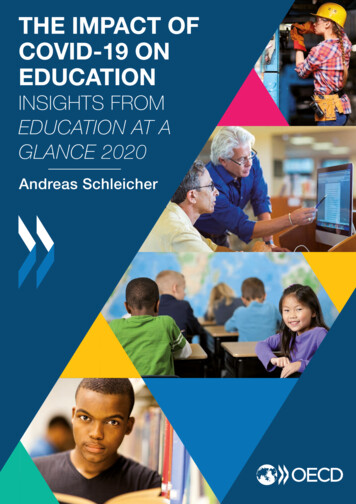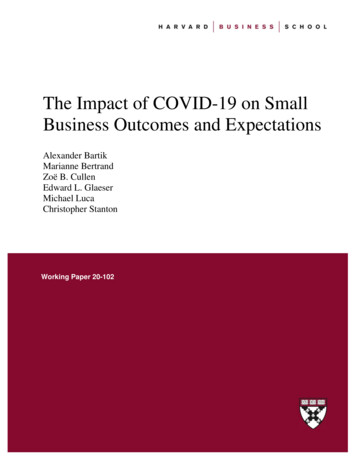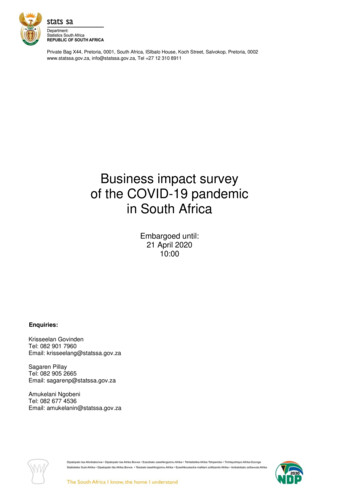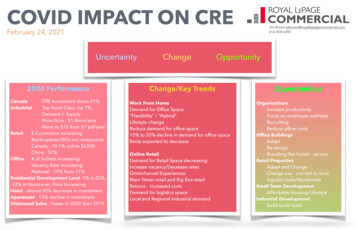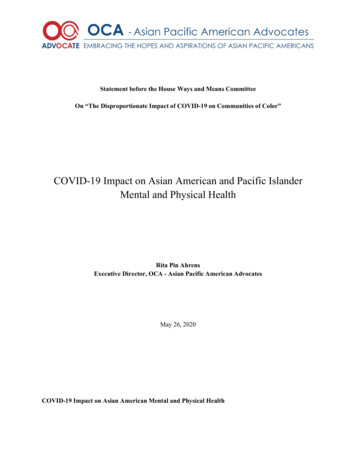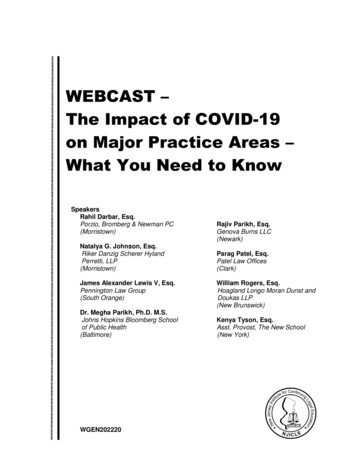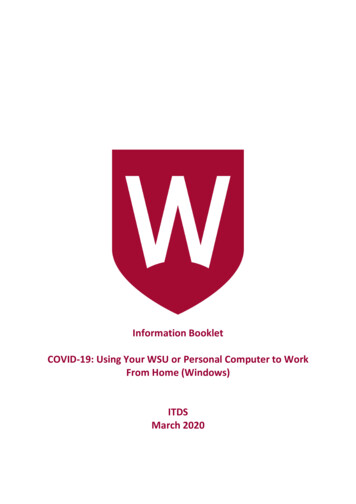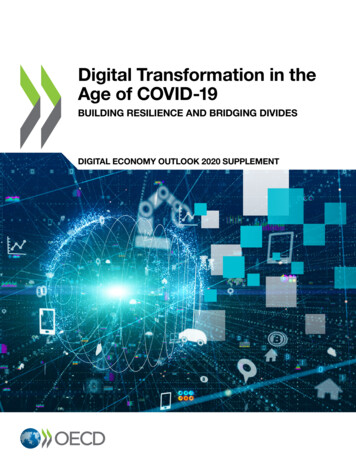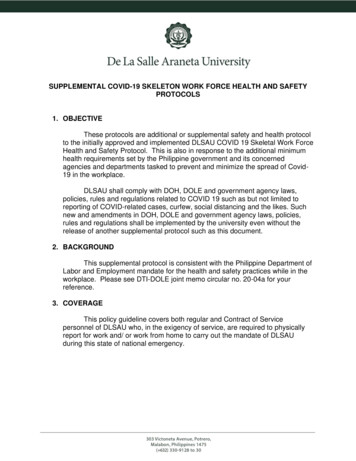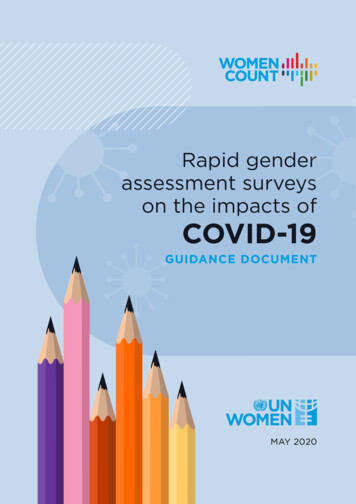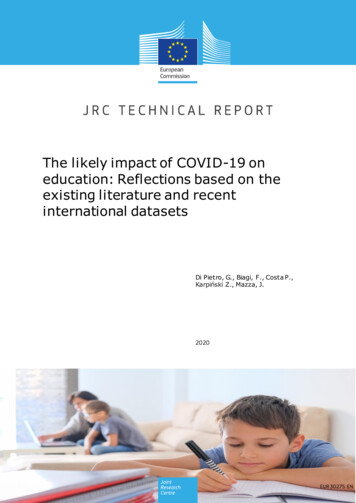
Transcription
The likely impact of COVID-19 oneducation: Reflections based on theexisting literature and recentinternational datasetsDi Pietro, G., Biagi, F., Costa P.,Karpiński Z., Mazza, J.2020EUR 30275 EN
This p ublication is a Technical re port by the Joint Research Ce ntre (JRC), the European Commission’s science and knowledge service. Itaims to p rovide evidence-based scientific support to the European p olicymaking process. The scientific output e xpressed does not imp ly ap olicy p osition of the European Commission. Neither the European Commission nor any p erson acting on behalf of the Commission isre sp onsible for the use that might be made of this publication. For information on the me thodology and quality underlying the data usedin this p ublication for which the source is neither Eurostat nor other Commission service s, users should contact the re ferenced sou rce. Thede signations employed and the p resentation of material on the maps do not imp ly the exp ression of any opinion whatsoever o n the p artof the European Union concerning the le gal status of any country, territory, city or are a or of its authoritie s, or concernin g the delimitationof its frontie rs or boundaries.Contact informationName : Giorgio Di PietroAddre ss: Edificio Exp o, c. Inca Garcilaso, 3, 41092 Seville (Spain)Email : giorgio.di-pietro@ec.europa.euTe l.: ( 34) 954488479EU Science Hubhttp s://ec.europa.eu/jrcJRC121071EUR 30275 ENPDFISBN 978-92-76-19937-3ISSN 1831-9424doi:10.2760/126686Luxe mbourg: Publications Office of the European Union, 2020 Europ ean Union, 2020The re use p olicy of the European Commission is imp le mented by the Commission Decision 2011/833/EU of 12 December 2011 on there use of Commission documents (OJ L 330, 14.12.2011, p . 39). Exce pt otherwise noted, the re use of this document is authorised underthe Cre ative Commons Attribution 4.0 International (CC BY 4.0) lice nce (http s://cre ativecommons.org/licenses/by/4.0/). This me ans thatre use is allowed p rovided appropriate cre dit is give n and any changes are indicated. For any use or re production of photos or othermate rial that is not owned by the EU, permission must be sought directly from the copyright holders.All conte nt European Union 2020, exce pt cover p icture: vejaa, 2020. Source: www.stock.adobe.comHow to cite this re p ort: Di Pietro, G., Biagi, F., Costa, P., Karpiński Z., Mazza, J, The like ly impact of COVID-19 on e ducation:Re fle ctions base d on the e xisting lite rature and inte rnational datase ts , EUR 30275 EN, Publications Office of the European Union,Luxembourg , 2020, ISBN 978-92-76-19937-3, doi:10.2760/126686, JRC121071
ContentsAbstract .2Acknowledgements.3Executive summary .41 Introduction.72 Physical school closure, remote schooling and learning.82.1 Less time spent in learning .82.2 Stress symptoms .92.3 A change in the way students interact .92.4 Lack of learning motivation. 102.5 Remote schooling. 103 Learning and inequality . 123.1 Non-financial parental support . 123.1.1 Cognitive skills . 123.1.2 Non-cognitive skills . 133.1.3 Amount of time at home with children . 143.2 Financial parental resources . 143.2.1 Digital resources at home. 143.2.2 Home learning environment. 163.2.3 Nutrition. 163.2.4 Affordability of extra-school activities . 193.3 Schools . 143.3.1 Digital infrastructure . 203.3.2 Teachers’ digital skills . 213.4 Students’ digital skills. 233.5 Natives vs Immigrants. 244 Conclusions . 285 Policy options . 31References . 36List of figures. 41Annexes . 42Annex 1. Computation of ‘c onservatives’ estimates of the average effect of COVID-19on student learning in a few selected EU countries . 42Annex 2. Computation of rough estimates of the long-term macro consequences of thelikely effect exerted by COVID-19 on education in France . 451
AbstractIn order to reduce the spread of COVID-19, most countries around the world have decidedto temporarily close educational institutions. However, learning has not stopped but is nowfully taking place online as schools and universities provide remot e schooling. Usingexisting literature and evidence from recent international data (Eurostat, PISA, ICILS,PIRLS, TALIS), this report attempts to gain a better understanding of how the COVID-19crisis may affect students’ learning. It looks at the different direct and indirect waysthrough which the virus, and the measures adopted to contain it , may impact children’sachievement. ‘Conservative’ estimates for a few selected EU countries consistently indicatethat, on average, students will suffer a learning loss. It is also suggested that COVID-19will not affect students equally, will influence negatively both cognitive and non-cognitiveskills acquisition, and may have important long-term consequences in addition to the shortterm ones.2
AcknowledgementsThe authors would like to thank various colleagues for their helpful and constructivecomments including Ioannis Maghiros and Riina Vuorikari (from JRC B4), StephanieCarretero and Joanna Napierala (from JRC B7), and Veronica De Nisi, Szilvia Kalman andAna-Maria Stan (from DG EAC).AuthorsThis paper was prepared by Giorgio Di Pietro, Federico Biagi, Patricia Costa, ZbigniewKarpiński and Jacopo Mazza.3
Executive summaryMost educational institutions around the world cancelled in-person instruction and movedto remote learning and teaching in March 2020 in an attempt to contain the spread ofCOVID-19. Parts of the (or the whole) formal education system will not re-open thisacademic year in some countries, whereas in others (parts of) the formal education systemhave progressively re-opened.While the disruption in learning caused by COVID-19 is unprecedented, important insightsabout its possible impact can be gained from findings of relevant existing studies and preCOVID-19 data.Although the adoption of distance learning is key to ensure the continuity of educationfollowing the physical closure of schools, students are, on average, likely to experience alearning loss during the lockdown. Several arguments can be put forward to explain this.First, there is evidence showing that quarantined students tend to spend less time inlearning compared to when schools are open. Second, many students confined at homedue to COVID-19 may feel stressed and anxious, and this may negatively affect their abilityto concentrate on schoolwork. Third, physical school closure and the lack of in-personcontact may make students less externally motivated to engage in learning activities.‘Conservative’ estimates for France, Italy and Germany suggest that students will suffer aweekly learning loss of between 0.82 and 2.3% of a standard deviation. Such loss reflectsthe reduction in test score students would be experiencing because of less time spent inlearning compared to the amount of time they typically invest when they are in school. Fora test which is scaled to have a mean of 500 and a standard deviation of 100, the impliedlearning loss over the whole period of lockdown would mean a reduction in scores ofbetween 6.5 and 14 points.The switch from offline to online learning caused by COVID-19 is likely to affect negativelythose children, in primary and lower secondary schools, who have higher difficulties inadapting to the new learning environment. The switch is also expected to exacerbateexisting educational inequalities. More vulnerable students, such as for instance those fromless advantaged backgrounds, are especially likely to fall behind during this emergencyperiod. These students are less likely to have access to relevant learning digital resources(e.g. laptop/computer, broadband internet connection) and less likely to have a suitablehome learning environment (e.g. a quiet place to study or their own desk). Additionally,they may not receive as much (direct or indirect) support from their parents as their moreadvantaged counterparts do. In more affluent families, parents are more likely to be ableto work from home and are also more likely to afford private online tuition. Schools mayfurther contribute to this inequality given that students from more advantagedbackgrounds may be more likely to attend schools with better ICT -based infrastructure(e.g. Virtual Learning Environment) and where teachers have higher levels of digital skills.Children of single parents or large families as well as students with special needs ordisabilities are also likely to suffer from the switch, unless assisted technologies arepromptly put in place and adapted to the new learning environment .Not only are COVID-19 and the move to remote learning and teaching expected to causegreater inequality in cognitive abilities, but they may exert a similar effect as regardstudents’ emotional well-being and motivation. In fact, students’ isolation from their friendsand teachers may result in an unequal distribution of behavioural and psychologicalproblems. During the lockdown, students from less advantaged backgrounds are morelikely to be exposed to a stressful home environment (e.g. they are more likely to share alimited space and a limited number of digital devices with other family members).Furthermore, parents in these households, who may be under pressure because of financialand job security issues due to the COVID-19 crisis, are probably not in the best position tosupport their children in these circumstances.The increased disparity in both cognitive and non-cognitive abilities that is likely to emergeduring COVID-19 pandemic may have important consequences not only in the short -term,but also in the long-term. Several studies find that children’s cognitive and socio-emotional4
skill levels are good predictors of later outcomes. Students poorly endowed with these skillstend to have lower educational attainment and poorer labour market prospects, in termsof both employment and pay rates. Therefore, there is the risk that, in the absence ofappropriate policy measures, the short-term inequality caused by COVID-19 may persistor even grow over time, leading to more economic disparity in the future.Finally, it is interesting to put the learning loss suffered by students during the COVID-19crisis into a broader perspective. Such loss will translate into a reduction of available humancapital, with negative effects on productivity growth, innovation and employment, includingfuture lower earnings for the student cohorts directly affected by the lockdown. Forexample, rough estimates indicate that the aggregate annual earnings loss that Frenchprimary school students will experience because of the COVID-19 confinement periodamounts to between 700 and 800 million euro. These values are much bigger if earningslosses across all educational levels are summed up. Such consideration and these numbersshould be kept in mind by policymakers when deciding about the budget to be invested inan attempt to mitigate the detrimental effects of COVID-19 on education.The effect of COVID-19 on education poses at least two key challenges for policymakers.First, measures should be taken to ensure that more vulnerable students will be able tomake up for the learning loss they experienced during the lockdown. This should be donequickly and effectively, in order to avoid that such crisis results in permanent educationand economic inequality. Second, given that there is the possibility that educationalinstitutions may not be able to operate fully in-person during parts of (or the whole) nextacademic year, alternative methods of delivering teaching and learning should be put inplace. Although a blended /rotating learning system (with offline and online elements) isan interesting option, it is important to note that: 1) it requires a change in both thequantit
about its possible impact can be gained from findings of relevant existing studies and pre-COVID-19 data. Although the adoption of distance learning is key to ensure the continuity of education following the physical closure of schools, students are, on average, likely to experience a learning loss during the lockdown. Several arguments can be put forward to explain this. First, there is .
